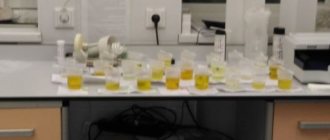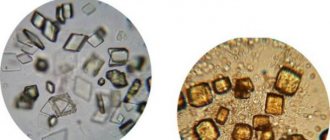General information and causes
Pyelonephritis is an inflammatory pathology of kidney structures such as the pelvis and calyces. The disease occurs as a result of pathogenic microflora entering the organ.
Bacteria cause inflammation of the kidney structures, which causes the characteristic clinical picture of pyelonephritis.
The causative agents of the disease are various pathogenic microorganisms that penetrate the urinary organs in various ways.
They can enter through the bloodstream from other sources of infection or ascending from the urethra.
Bacteria penetrate the kidney parenchyma, the pyelocaliceal system of the organ, where they begin to multiply, thereby causing an inflammatory process.
The causative agents most often are Escherichia coli, Proteus, microorganisms from the group of enterococci and streptococci.
Predisposing factors to the onset of the disease are processes such as stagnation of urine, age over 50 years, frequent hypothermia, hormonal disorders, and decreased activity of the immune system.
In the presence of pathologies such as urolithiasis, chronic prostatitis, cystitis, urethritis and sexually transmitted diseases, the risk of getting sick increases.
Classification and types
Pyelonephritis in men can be primary and secondary. The first type occurs against the background of complete health of the patient, the second - in the presence of sources of chronic infection.
When one kidney is affected, the pathology is called unilateral, while when two kidneys are affected, it is called bilateral.
According to the nature of the inflammatory process, the disease can be serous or purulent. Depending on the characteristics of the course, pyelonephritis is divided into acute and chronic.
Acute manifestation
This type of disease occurs suddenly and is characterized by the presence of a clear clinical picture. Patients are often bothered by severe pain resulting from swelling of the kidney and stretching of its capsule.
The general condition of the body always suffers - patients’ body temperature rises, complaints of headaches, weakness, and depression appear.
Chronic appearance
The chronic form of pyelonephritis is characterized by alternating relapses and remissions. This happens due to incomplete treatment of the acute form of the pathology and failure to follow the doctor’s recommendations for maintaining a healthy lifestyle.
During exacerbations, there is no clear clinical picture, the symptoms are blurred. In some cases, patients are not bothered at all.
Chronic pyelonephritis is dangerous because it can provoke renal failure, which can pose a threat to the patient’s life.
Clinical picture
The clinical picture in men is characterized by the presence of symptoms common to pyelonephritis. It looks like this:
- Patients immediately experience an increase in body temperature . The numbers can be high - up to 39-40 degrees. Patients complain of chills and severe sweating. The temperature can remain at this level for quite a long time.
- Pyelonephritis leads to the occurrence of intoxication phenomena . Patients are concerned about nausea, vomiting, headaches and dizziness, general weakness, and lack of appetite.
- The disease is characterized by a pronounced aching pain syndrome in the lumbar spine.
- The process of urination is accompanied by sharp pain , the urine itself is cloudy, and sometimes there may be blood in it. The number of urges also increases.
The symptoms listed above are characteristic of the acute form of pyelonephritis. In the chronic course of the disease, the patient's general condition rarely suffers. Most often, they are bothered by mild pain in the lumbar region, a slight increase in temperature and discomfort when urinating.
Long duration of chronic pyelonephritis can lead to arterial hypertension, digestive disorders and weight loss.
Stages of flow
During acute pyelonephritis, several stages are distinguished. With the first, serous inflammation of the organ is observed, which lasts up to 2 days.
Then a large number of small foci of pus form, which can merge with each other into larger formations. In severe cases, a kidney abscess can form, which can melt the organ tissue.
In chronic pyelonephritis, the stages of the course vary. During the first stage, the glomeruli and tubules of the kidney are not damaged. Then sclerosis of the feeding vessels is noted, the structure of the elements changes. This is the second stage of the process.
In the third, necrosis of most of the glomeruli is diagnosed. During the fourth stage, almost all the glomeruli die, the kidney itself becomes wrinkled, and it is unable to perform its functions.
Symptoms
Signs of kidney inflammation can be general as well as local. Common symptoms in men are:
- chills preceding a sharp rise in temperature;
- nausea, weakness, regurgitation;
- headache;
- profuse sweating.
The acute form occurs with the following local symptoms:
- Pollakiuria. Urination becomes frequent, scanty, and painful. There is an imaginary urge that does not end with a bowel movement.
- Paroxysmal pain due to pyelonephritis in the lower back, which is not relieved by standard painkillers.
- The urine becomes dark and foul-smelling. If blood is found in it, this is an unfavorable sign.
- Nocturia develops - frequent urges at night.
- Urinary incontinence occurs.
- In extreme situations, an abscess develops, in which immediate surgery is necessary.
The chronic course replaces the unsuccessfully treated acute one. It occurs with erased signs, in which stages of remission alternate with phases of manifestation .
Symptoms of the disease
The main symptoms of the permanent form of the disease are the following:
- aching lumbar pain;
- pressure changes;
- enuresis;
- abdominal pain, burning sensation when emptying the bladder;
- reflux is the reverse flow of urine. Accompanied by intoxication. It is observed mainly in elderly patients.
Who to contact and how to diagnose
Patients with symptoms of pyelonephritis should consult a urologist or nephrologist. The doctor will examine the patient, collect anamnesis, prescribe a general blood and urine test, and a biochemical blood test.
These methods make it possible to detect the presence of an inflammatory process and show the functioning of organs. Urine culture is performed to determine the pathogen and its sensitivity to antibacterial drugs.
An ultrasound examination of the pelvic and abdominal organs is mandatory. Patients often undergo urography to identify abnormal urinary flow.
In some situations (to clarify the diagnosis and areas of damage), patients may need computed tomography or magnetic resonance imaging.
Methods of therapy
Treatment of pyelonephritis in men is complex. Tactics are determined individually and depend on the general condition, the nature of the pathology, and concomitant diseases.
Traditional methods
First of all, it is necessary to eliminate the pain syndrome. For this purpose, drugs based on metamizole sodium or drotaverine (for example, Analgin or Baralgin) in injection forms are used.
Patients are then prescribed antibiotic therapy, which is determined only by the attending physician based on urine culture results.
Typically, drugs from the cephalosporin group (Ceftriaxone, Ceftazidime), ampicillin with clavulanic acid, and clarithromycin are prescribed. The duration and frequency of administration is established and adjusted only by the attending physician.
Typically, antibiotics are stopped 3 days after body temperature normalizes. Before this, it is important to conduct a control test of urine and blood.
In addition to antibacterial drugs, probiotics are added (for example, Linex). This group of drugs prevents the death of beneficial intestinal microflora, which is often observed when taking antibiotics for a long time.
After eliminating acute phenomena, patients can be prescribed uroseptic drugs that have an antimicrobial effect - Canephron, Fitolysin. They are taken in courses of 2-3 months.
In severe cases of the disease, patients may undergo surgical interventions. With a widespread purulent process, the question of removing the kidney often arises. To improve the flow of urine, patients can undergo operations to create a special stoma, which facilitates the process of urination. This intervention is reversible; after recovery, the stoma is removed.
Treatment at different stages
Treatment tactics depend on the stage of the pathology. For acute pyelonephritis, antibiotic therapy is sufficient in most cases. In a situation where a kidney abscess or other complications form, we are talking about performing surgical intervention.
In case of chronic pyelonephritis, patients are advised to follow recommendations for lifestyle changes.
For exacerbations, conservative therapy is sufficient. If patients are diagnosed with severe renal failure, then the question of surgical treatment may also arise.
ethnoscience
There are a large number of traditional methods for treating pyelonephritis in men. One of them is the use of lingonberry infusion. A spoonful of plant leaves is boiled in 200 ml of water for 15 minutes. After straining, you need to drink 2 tablespoons three times a day.
You can use bearberry. A spoon of the plant is filled with 200 ml of water. The resulting mixture is kept in a water bath for half an hour. After this, the broth must be cooled and strained.
A spoonful of the resulting drink is diluted in a glass of water, a quarter of which is drunk 3 times a day.
Another effective method of folk treatment is the use of oat decoction. The plant is boiled for half an hour. You need to drink 2 glasses throughout the day. Duration of use – 3 weeks.
The nature of pyelonephritis
Pyelonephritis is an inflammatory disease caused by bacteria. Despite the fact that women more often suffer from manifestations of pyelonephritis, pyelonephritis also occurs in men. Among men, people of retirement age are especially susceptible to it. This has the following explanation: the most common cause of pyelonephritis is advanced diseases of the urinary and reproductive systems. In this case, we can say that pyelonephritis is of a secondary nature.
In addition to untreated diseases such as kidney stones, which significantly increase the likelihood of pyelonephritis, pyelonephritis in men equally occurs due to the presence of purely urological diseases, for example, prostatitis. Pyelonephritis itself in men can have either an acute course or a protracted course. The degree of damage to the renal pelvis in this disease depends on the timely diagnosis of the disease, the treatment undertaken, the age of the patient, the presence of similar diseases, forms of pyelonephritis and many other factors. However, in any case, comprehensive treatment is necessary to get rid of pyelonephritis. Ignoring this disease can cost the patient's health, and in some cases even his life.
Causes of pyelonephritis in men
Since pyelonephritis is inflammatory in nature, its main causes remain hypothermia and bacterial infection. A weakened immune system can also contribute to the occurrence of this disease. In addition to a cold, the occurrence of pyelonephritis can be facilitated by the presence of other diseases of the genitourinary system that interfere with the normal removal of urine from the kidneys. Among them are the following:
- the presence of kidney stones;
- chronic prostatitis;
- BPH.
Moreover, the occurrence and development of pyelonephritis is significantly influenced by deviations in the endocrine system. Among them are diabetes mellitus and other hormonal imbalances. Also, the appearance of pyelonephritis can be caused by different strains of bacteria. They can enter the patient’s body either through the urinary tract or by wandering through the blood.
The entry of bacteria into the renal pelvis is more often associated with a wandering infection inside the man’s body, since the structure of the male urinary system practically excludes the penetration of microorganisms through the ureter. It is for this same reason that men are less likely to suffer from chronic forms of this disease.
Despite its bacterial nature, pyelonephritis is not a disease that is transmitted through household or sexual contact. However, you should be careful when in close contact with a person who suffers from this disease, since pyelonephritis is often accompanied by other infectious diseases, including sexually transmitted diseases.
Symptoms of pyelonephritis in men
Manifestations of pyelonephritis in men, the disease itself and the nuances of its course depend on the stage of development of inflammation, the presence of concomitant diseases, as well as the age and general health of the patient. A feature of pyelonephritis in men is its ability to occur in a latent form for quite a long time and without obvious signs characteristic of this disease.
The most common symptoms of pyelonephritis are:
- frequent and painful urge to urinate;
- pain, burning, cramping in the urinary tract;
- imaginary urge to go to the toilet, sometimes incontinence;
- nagging or aching pain in the lower back and lower back;
- increased fatigue, decreased activity;
- hypertension;
- in particularly acute or advanced forms, poisoning of the body, which is accompanied by pain, fever, nausea, vomiting, and trembling, cannot be ruled out.
When infected with bacteria, the course of pyelonephritis in men, as well as the symptoms of the disease, can also be influenced by the type of strain with which the infection occurred. In order to correctly determine the type of microorganisms, the attending physician suggests that the patient take urine and blood tests.
Some advanced forms of pyelonephritis can last for years, hiding their symptoms. The only evidence of the presence of an inflammatory process in the body is often only increased blood pressure. But despite its latent nature, this form of pyelonephritis can significantly undermine the functionality of organs and the general health of the patient.
Diagnosis of pyelonephritis
The presence of latent forms of pyelonephritis, as well as not always clear symptoms, complicate the detection and treatment of this disease.
Not only the success of treatment, but also the ability to preserve the patient’s health and the functionality of the urinary and reproductive systems depends on the timely detection of pyelonephritis.
Diagnostic methods
Since very often several reasons at once give rise to the development of pyelonephritis, pyelonephritis in men must be diagnosed comprehensively. To detect symptoms of inflammatory kidney disease, the attending physician carries out a certain sequence of actions.
- Measuring blood pressure is an essential step upon admission to hospital. The measurement is most often taken in a doctor's office.
- If it is necessary to confirm the presence of pyelonephritis, pyelonephritis in men should be diagnosed by urine tests. They usually indicate the presence of hyposthenuria.
- A blood test is important in diagnosis. With pyelonephritis, a large number of leukocytes and a reduced number of red blood cells are present in the blood.
- After passing the tests, it is also advisable to conduct an ultrasound diagnosis of the kidneys and other organs of the genitourinary system. This will help clarify the diagnosis.
The obtained test results make it possible to judge the form, stage and type of the causative agent of pyelonephritis, if its cause is a bacterial infection, as well as to select the correct treatment.
Complications
Pyelonephritis is dangerous due to its complications. The acute form of the disease can lead to the formation of an abscess. Pus can break through the capsule of the organ, spread to the surrounding tissue, the second kidney, and beyond the abdominal cavity. This can lead to peritonitis and sepsis. These pathologies pose a threat to the patient's life.
Prolonged course of pyelonephritis can provoke arterial hypertension, the treatment of which is problematic. Patients usually require surgery.
If the disease becomes chronic, it often leads to kidney failure. The pathology is unfavorable; such patients often require transplantation.
Features of the treatment of pathology in children
Pyelonephritis in children is treated using different groups of medications: sulfonamides, antibiotics, nitrofurans. Fluoroquinol compounds should not be used to treat children under 12 years of age, as they are highly toxic. Antibacterial drugs, duration of treatment, combination of antibiotics - all these issues are decided by the attending physician based on the results of the examination.
After the disease enters the chronic stage, the child’s condition is monitored for several more years. Antibacterial therapy is continued in intermittent courses. If pyelonephritis appears as a result of abnormal development of the urinary ducts, the issue of eliminating the cause of the disease through surgery is decided.
The child's condition should be constantly monitored by a urologist and pediatrician. In this case, leukocyturia indicators are examined, and blood pressure is regularly measured. Ultrasounds are done every 6-12 months. These measures will help avoid severe complications such as kidney failure, urolithiasis, and arterial hypertension.
Prevention and prognosis
If you consult a doctor in a timely manner and continue to follow all recommendations, the prognosis for the disease is favorable. To prevent pyelonephritis, men need to avoid hypothermia, get rid of bad habits, and sanitize all sources of chronic infections in the body.
You can take urological herbal mixtures or herbal preparations (for example, Canephron) in courses. It is also effective in preventing recurrence of pyelonephritis.
This pathology requires early diagnosis and careful treatment. This will help avoid complications that can seriously affect the patient’s quality of life.
It is important for elderly men with concomitant pathologies of the pelvic organs to carefully monitor their condition, since they are at risk and pyelonephritis itself is more severe in them.
Can diet help with pyelonephritis?
When diagnosed with such a complex disease, men are required to follow a diet and completely exclude the following foods and drinks from their diet:
- alcohol-containing liquids, especially beer;
- nicotine;
- narcotic drugs;
- antibiotics that are taken without the supervision of medical professionals;
- fast food and convenience foods;
- food that contains a significant amount of salt;
- smoked meats
Compliance with the prescribed diet will help defeat the disease in a short time.










